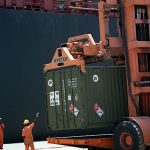ILA Already Threatening Strike
ILA Tells Members to Prepare for Possible Coastwide Strike

If there’s one word shippers hate to hear in relation to the dockworkers and their unions that control the jobs up and down the U.S. coasts, it’s strike. We’re a little under a year away from the contract between the International Longshoremen’s Association (ILA), representing dockworkers at the East and Gulf Coast ports, and the United States Maritime Alliance (USMX), representing employers at those ports, expiring. However, the ILA is already talking strike.
We’ve barely gotten past the long, contentious, on-again and off-again contract negotiations between the International Longshore & Warehouse Union (ILWU) and the Pacific Maritime Association (PMA) on the West Coast, which to no one’s surprise included port-disrupting labor action and had shippers diverting imports and exports through East and Gulf Coast ports. Now, shippers have to get ready to deal with unpredictable labor action, which could include a strike, at those East and Gulf Coast ports.

It’s Miller Time. For those of you who regularly read this blog, you know that doesn’t mean the unions are driving me to drink. Miller Time means we’re checking out a FreightWaves article by Greg Miller. Sometimes, I even use Miller Time as a nickname for the man himself. Here’s what Miller Time reported:
“Members should prepare for the possibility of a coastwide strike in October 2024,” the International Longshoremen’s Association (ILA) — the union representing 45,000 East and Gulf Coast dockworkers — warned in a press release on Saturday.
The current six-year agreement expires on Sept. 30, 2024. “The union will hold firm on its pledge not to extend the contract beyond its expiration date,” said the ILA.
Relatively Smooth Decade
Traditionally, the dockworker unions don’t agree to a new contract before the previous one expires. That’s long documented and basically a matter of policy for both the ILA and ILWU. This policy allows the unions to use their biggest weapons of leverage in negotiations: slowdowns, strikes, and threats of strike.
While ILWU contract negotiations pretty much always mean labor action and port disruptions, ILA contract negotiations have actually been surprisingly smooth over the last decade.
Backlash from massive port disruptions during the 2014-15 ILWU negotiations led to market share gains for East and Gulf Coast ports. It also seemed to make the ILA and USMX realize change needed to happen with how labor negotiations at the ports was handled.
Only about a year before the messy and costly negotiations on the West Coast, negotiations between the ILA and USMX on the East Coast were contentious, with the ILA threatening to strike. Ships were being diverted from East and Gulf Coast ports and market share was being gained by the West Coast ports. Here in Universal Cargo’s blog, we were keeping shippers informed with the 2012/13 ILA Strike Watch.
The ILA and USMX seemed to have learned a lesson that they were better off keeping negotiations smooth instead of trading back and forth discretionary cargo with the West Coast depending on who was disrupting supply chains because of contract negotiations that year. The ILA’s move toward more port stability with smooth new contract negotiations or extensions seemed to rub off on the ILWU as well. In 2017, the ILWU actually reached a contract extension agreement before their contract at the time expired. We were living in new, unprecedented times.
Unfortunately, they didn’t last.
Labor Action Ramps Up
Now is a time when unions in various industries all over the globe, and especially in North America, are ready to strike for higher pay. Business be damned. It appears to be paying off for them. The ILWU’s contentious negotiations resulted in massive pay gains. Of course, the ILA wants to get big pay raises for its members as well (and more control of the jobs at the ports). It may take port disruption. It may result in higher costs for shippers and consumers. It may even cost union jobs down the road. But the dockworker unions seem to be done diverted from their traditional, disruptive contract negotiation tactics. With the ILWU executing port disruptions during their drawn-out negotiations and the ILA already talking strike, the lesson learned from the 2012-13 ILA strike threat and 2014-15 ILWU port congestion appears to be lost.
The ILA is ready to stop the flow of goods through East and Gulf Coast ports to get its extremely high wage demands met. Miller Time reports:
“If it goes to the wire, I will guarantee there will be no extensions and we will be out on the street,” said Daggett at the July convention. “Don’t come back and say we cannot afford that kind of raise. You definitely can afford it — and you know it.”
The United States Marine Alliance (USMX) represents dockworker employers at East and Gulf Coast ports and shipping lines serving those facilities. The ILA is seeking a new contract from USMX that includes “a landmark compensation package,” prohibitions against terminal automation and tightened language ensuring all work at new terminals goes to ILA members.
ILA Already Showing It’s Serious with Terminal Stranglehold
Of course, over the last couple years, the ILA has been showing it still has the will to flex its muscle and stop the flow of goods to get what it wants. In 2021, I wrote about the ILA putting a stranglehold on what was a new terminal at the Port of Charleston. We’re approaching three years since the Hugh K. Leatherman Terminal opened at the Port of Charleston, but it has gone largely unused despite great need for it, particularly during the shipping boom.
The ILA is fighting for control of all the jobs at the terminal instead of the traditional hybrid labor model of employing union members and state employees there. The ILA sued over the issue, and the case could make it to the Supreme Court. Getting rid of the hybrid model, so the ILA controls all jobs at the East and Gulf Coast ports could play a big role in the upcoming contract negotiations, as could the issue of automation.
In the meantime, shippers may want to start planning ahead for shipping options in October of 2024 that divert cargo away from East and Gulf Coast ports as much as possible.





